Advertisements
Online Mock Tests
Chapters
1: Force
2: Work, Energy and Power
3: Machines
LIGHT
▶ 4: Refraction of Light at Plane Surfaces
5: Refraction through a Lens
6: Spectrum
SOUND
7: Sound
ELECTRICITY AND MAGNETISM
8: Current Electricity
9: Household Circuits
10: Electro-Magnetism
HEAT
11: Calorimetry
MODERN PHYSICS
12: Radioactivity
![Selina solutions for Physics [English] Class 10 ICSE chapter 4 - Refraction of Light at Plane Surfaces Selina solutions for Physics [English] Class 10 ICSE chapter 4 - Refraction of Light at Plane Surfaces - Shaalaa.com](/images/physics-english-class-10-icse_6:4c973dd038c545c9a2b6db170ad2f542.jpg)
Advertisements
Solutions for Chapter 4: Refraction of Light at Plane Surfaces
Below listed, you can find solutions for Chapter 4 of CISCE Selina for Physics [English] Class 10 ICSE.
Selina solutions for Physics [English] Class 10 ICSE 4 Refraction of Light at Plane Surfaces EXERCISE - 4 (A) [Pages 80 - 82]
What do you understand by refraction of light?
Draw diagrams to show the refraction of light from
- air to glass, and
- glass to air. In each diagram, label the incident ray, refracted ray, the angle of incidence
- and the angle of refraction (r).
-
- the angle of refraction and
- the angle of deviation for the ray?
An obliquely incident light ray bends at the surface due to a change in speed when passing from one medium to another. The ray does not bend when it is incident normally. Will the ray have a different speed in the other medium?
What is the cause of refraction of light when it passes from one medium to another?
A light ray suffers reflection and refraction at the boundary in passing from air to water. Draw a neat labelled ray diagram to show it.
A ray of light passes from medium 1 to medium 2. Which of the following quantities of the refracted ray will differ from that of the incident ray: Speed, intensity, frequency, wavelength?
State the Snell’s laws of refraction of light.
Define the term refraction index of a medium. Can it be less than 1?
Compare the speeds of light of wavelength 4000 Å (i.e. violet light) and 8000 Å (i.e. red light) in vacuum.
A light ray passes from water to
- air, and
- glass.
In each case, state how does the speed of light change.
A light ray in passing from water to a medium (a) speeds up (b) slows down. In each case,
- give one example of the medium.
- state whether the refractive index of medium is equal to, less than or greater than the refractive index of water.
What do you understand by the statement 'the refractive index of glass is 1·5 for white light'?
A monochromatic ray of light passes from air to glass. The wavelength of light in air is λ, the speed of light in air is c and in glass is V. If the absolute refractive index of glass is 1.5, write down
- the relationship between c and V,
- the wavelength of light in glass.
A boy uses the blue colour of light to find the refractive index of glass. He then repeats the experiment using the red colour of light. Will the refractive index be the same or different in the two cases? Give a reason to support your answer.
For which colour of white light, is the refractive index of a transparent medium the most?
Which colour of white light travels fastest in any medium except air?
Name two factors on which the refractive index of a medium depends. State how does it depend on the factors stated by you.
How does the refractive index of a medium depend on the wavelength of light used?
How does the refractive index of a medium depend on its temperature?
Light of a single colour is passed through a liquid having a piece of glass suspended in it. On changing the temperature of liquid, at a particular temperature the glass piece is not seen. When is the glass piece not seen?
Light of a single colour is passed through a liquid having a piece of glass suspended in it. On changing the temperature of liquid, at a particular temperature, the glass piece is not seen.
Why is the light of a single colour used ?
A ray of light A incident from air suffers partial reflection and refraction at the boundary of water.
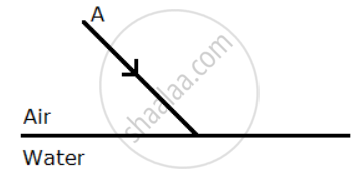
- Complete the diagram showing (i) the reflected ray B and (ii) the refracted ray C.
- How are the angles of incidence i and refraction r related?
The diagram alongside shows the refraction of a ray of light from air to a liquid.
- Write the values of (i) angle of incidence, (ii) angle of refraction.
- Use Snell’s law to find the refractive index of liquid with respect to air.

The refractive index of water with respect to air is aμw and of glass with respect to air is aμg. Express the refractive index of glass with respect to water.
What is lateral displacement?
Draw a ray diagram showing the lateral displacement of a ray of light when it passes through a parallel sided glass slab.
A ray of light strikes the surface of a rectangular glass slab such that the angle of incidence in air is
- 0°,
- 45°.
In each case, draw a diagram to show the path taken by the ray as it passes through the glass slab and emerges from it.
In the adjacent diagram, AO is a ray of light incident on a rectangular glass slab.
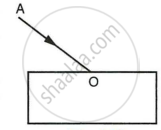
- Complete the path of the ray till it emerges out of the slab.
- In the diagram, mark the angle of incidence (i) and the angle of refraction (r) at the first interface. How is the refractive index of glass related to the angles i and r?
- Mark angles of emergence by the letter e. How are the angles i and e related?
- Which two rays are parallel to each other? Name them.
- Indicate in the diagram the lateral displacement between the emergent ray and the incident ray. State one factor that affects the lateral displacement.
A ray of green light enters a liquid from air, as shown in Fig. The angle 1 is 45° and angle 2 is 30°.

- Find the refractive index of the liquid.
- Show in the diagram the path of the ray after it strikes the mirror and re-enters in air. Mark in the diagram the angles where ever necessary.
- Redraw the diagram if plane mirror becomes normal to the refracted ray inside the liquid. State the principal used.
When an illuminated object is held in front of a thick plane glass mirror, several images are seen, out of which the second image is the brightest. Give reason.
When light travels from a rarer to a denser medium, its speed ______.
When light travels from a denser to a rarer medium, its speed ______.
The refractive index of glass with respect to air is 3/2. The refractive index of air with respect to glass will be ______.
MULTIPLE CHOICE TYPE
When a ray of light from air enters a denser medium, it ______.
Bends away from the normal
Bends towards the normal
Goes undeviated
Is reflected back
A light ray does not bend at the boundary in passing from one medium to the other medium if the angle of incident is ______.
0°
45°
60°
90°
The highest refractive index is of ______.
Glass
Water
Diamond
Ruby
NUMERICALS
The speed of light in air is 3 × 108 m s-1. Calculate the speed of light in glass. The refractive index of glass is 1.5.
The speed of light in diamonds is 125,000 km s-1. What is its refractive index? (speed of light in air = 3 × 108 ms-1).
The refractive index of water with respect to air is 4/3. What is the refractive index of air with respect to water?
A ray of light of wavelength 6600 Å suffer refraction from air to glass. Taking \[\ce{_a\mu_g = \frac{3}{2}}\], find the wavelength of light in glass.
Selina solutions for Physics [English] Class 10 ICSE 4 Refraction of Light at Plane Surfaces EXERCISE - 4 (B) [Pages 87 - 88]
What is prism?
With the help of diagram of the principal section of a prism, indicate its refracting surfaces, refracting edge and base.
Diagrams (a) and (b) in figure below show the refraction of a ray of light of single colour through a prism and a parallel sided glass slab respectively.
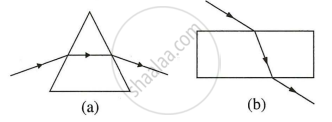
- In each diagram, label the incident, refracted, emergent rays and the angle of deviation.
- In what way the direction of emergent ray in the two cases differ with respect to the incident ray? Explain your answer.
Define the term angle of deviation.
Angle of deviation is the angle which the ______ ray makes with the direction of ______ray.
What do you understand by the deviation produced by a prism? Why is it caused?
State three factors on which the angle of deviation depends.
How does the angle of deviation produced by a prism change with increase in the angle of incidence. Draw a curve showing the variation in the angle of deviation with the angle of incidence at a prism surface.
Using the curve, how do you infer that for given prism, the angle of minimum deviation δmin is unique for the given light?
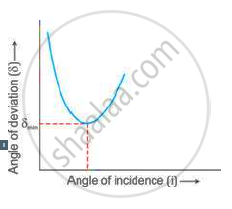
The deviation produced by a prism is independent of the angle of incidence and is same for all the colours of light.
True
False
How does the deviation produced by a prism depend on the refraction index of its material.
How does the deviation produced by a prism depend on the wavelength of incident light?
How does the angle of minimum deviation produced by a prism change with increase in
- the wavelength of incident light, and
- the refracting angle of prism?
Write a relation for the angle of deviation (δ) for a ray of light passing through an equilateral prism in terms of the angle of incidence (i1) angle of emergence (i2) and angle of the prism (A).
A ray of light incident at an angle of incidence i1 passes through an equilateral glass prism such that the refracted ray inside the prism is parallel to its base and emerges at an angle of emergence i2.
- How is the angle of emergence ‘i2’ related to the angle of incidence ‘i1’.
- What can you say about the angle of deviation in such a situation?
Draw a ray diagram to show the refraction of a monochromatic ray through a prism when it suffers a minimum deviation. How is the angle of emergence related to the angle of incidence in this position.
A light ray of yellow colour is incident on an equilateral glass prism at an angel of incidence equal to 48° and suffers minimum deviation by an angle of 36°.
- What will be the angle of emergence?
- If the angle of incidence is changes to (a) 30°, (b) 60°, state whether the angle of deviation will be equal to, less than or more than 36°?
Name the colour of white light which is deviated the most on passing through a prism.
Name the colour of white light which is deviated the least on passing through a prism.
Which of the two prism, A made of crown glass and B made of flint glass, deviates a ray of light more?
How does the angle of deviation depend on the refracting angle of the prism?
An object is viewed through a glass prism with its vertex pointing upwards. Draw a ray diagram to show the formation of its image as seen by the observer on the other side of the object.
A ray of light is normally incident on one face of an equilateral glass prism. Answer the following:
What is the angle of incidence on the first face of the prism?
A ray of light is normally incident on one face of an equilateral glass prism. Answer the following:
What is the angle of refraction from the first face of the prism?
A ray of light is normally incident on one face of an equilateral glass prism. Answer the following:
What will be the angle of incidence at the second face of the prism?
A ray of light is normally incident on one face of an equilateral glass prism. Answer the following:
Will the light ray suffer minimum deviation by the prism?
In following figure shows two identical prisms A and B placed with their faces parallel to each other. A ray of light of single colour PQ is incident at the face of the prism A. Complete the diagram to show the path of the ray till it emerges out of the prism B.
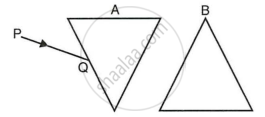
[Hint: The emergent ray out of the prism B will be parallel to the incident ray PQ]
MULTIPLE CHOICE TYPE
In refraction of light through a prism, the light ray ______.
Suffers refraction only at one face of the prism
Emerges out from the prism in a direction parallel to the incident ray
Bends at both the surfaces of prism towards its base
Bends at both the surfaces of prism opposite to its base
A ray of light suffers refraction through an equilateral prism. The deviation produced by the prism does not depend on the ______.
Angle of incidence
Colour of light
Material of prism
Size of prism
NUMERICALS
A ray of light incident at an angle of incidence 48° on a prism of refracting angle 60° suffers minimum deviation. Calculate the angle of minimum deviation.
[Hint: δmin = 2i - A]
What should be the angle of incidence for a ray of light which suffers a minimum deviation of 36° through an equilateral prism?
[Hint: A = 60°, i = (A + δmin)/2]
Selina solutions for Physics [English] Class 10 ICSE 4 Refraction of Light at Plane Surfaces EXERCISE - 4 (C) [Pages 91 - 92]
How is the refractive index of a medium related to the real and apparent depths of an object in that medium?
Prove that
Refractive index = `"Real depth"/"Apparent depth"`
A tank of water is viewed normally from above.
- State how does the depth of tank appear to change.
- Draw a labelled ray diagram to explain your answer.
Water in a pond appears to be only three-quarters of its actual depth.
- What property of light is responsible for this observation? Illustrate your answer with the help of a ray diagram.
- How is the refractive index of water calculated from its real and apparent depth?
Draw a ray diagram to show the appearance of a stick partially immersed in water. Explain your answer.
A fish is looking at a 1.0 m high plant at the edge of the pond. Will the plant appear shorter or taller than its actual height, to the fish. Draw a ray diagram to support your answer.
A student puts his pencil into an empty trough and observes the pencil from the position as indicated in
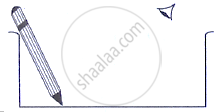
- What change will be observed in the appearance of the pencil when water is poured into the trough?
- Name the phenomenon which accounts for the above stated observation.
- Complete the diagram showing how the student’s eye sees the pencil through water.
An object placed in one medium when seen from the other medium, appears to be vertically shifted. Name two factors on which the magnitude of shift depends and state how does it depend on them.
MULTIPLE CHOICE TYPE
A small air bubble in a glass block when seen from above appears to be raised because of ______.
Refraction of light
Reflection of light
Reflection and refraction of light
None of the above
An object in a denser medium when viewed from a rarer medium appears to be raised. The shift is maximum for ______.
Red light
Violet light
Yellow light
Green light
NUMERICALS
A water pond appears to be 3 m deep. If the refractive index of water is 4/3, find the actual depth of the pond.
A coin is placed at the bottom of a beaker containing water (refractive index = 4/3) at a depth of 16 cm. By what height the coin appears to be raised when seen from vertically above?
A postage stamp kept below a rectangular glass block of refractive index 1.5 when viewed from vertically above it, appears to be raised by 7.0 mm. Calculate the thickness of the glass slab.
Selina solutions for Physics [English] Class 10 ICSE 4 Refraction of Light at Plane Surfaces EXERCISE - 4 (D) [Pages 100 - 102]
Explain the term critical angle with the aid of a labelled diagram.
How is the critical angle related to the refractive index of a medium?
State the approximate value of the critical angle for glass-air surface.
State the approximate value of the critical angle for water-air surface.
What is meant by the statement, ‘the critical angle for diamond is 24°’?
A light ray is incident from a denser medium on the boundary separating it from a rarer medium at an angle of incident equal to the critical angle. What is the angle of refraction for the ray?
Name two factors which affect the critical angle for a given pair of media. State how do the factors affect it.
- red light,
- blue light?
Which colour of light has a higher critical angle? Red light or green light.
What is total internal reflection?
State two conditions necessary for total internal reflection to occur.
Draw diagram to illustrate the total internal reflection.
Total internal reflection occurs only when a ray of light passes from a ______ medium to a ______ medium.
Critical angle is the angle of ______ in denser medium for which the angle of ______ in rarer medium is ______.
If the angle of incidence is greater than the critical angle, light is not refracted at all, when it falls on the surface from a denser medium to a rarer medium.
True
False
The refractive index of air with respect to glass is expressed as `""_g μ_a=sin i /sin r`.
- Write down a similar expression for aμg in terms of the angles i and r.
- If angle r = 90°, what is the corresponding angle i called?
- What is the physical significance of the angle i in part (b)?
In the following figure, show two rays A and B travelling from water to air. If the critical angle for water- air surface is 48°, complete the ray diagram showing the refracted rays for each. State conditions when the ray will suffer total internal reflection.

The given figure shows a point source P inside a water container. Three rays A, B, and C starting from the source P are shown up to the water surface.
- Show in the diagram the path of these rays after striking the water. The critical angle for water-air surface is 48°.
- Name the phenomenon which the rays A, B, and C exhibit.

In the given figure PQ and PR are the two light rays emerging from an object P. The ray PQ is refracted as QS.
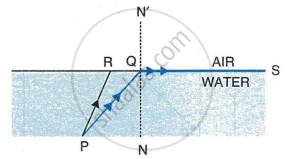
- State the special name given to the angle of incidence ∠PQN of the ray PQ.
- What is the angle of refraction for the refracted ray QS?
- Name the phenomenon that occurs if the angle of incidence ∠PQN is increased.
- The ray PR suffers partial reflection and refraction on the water-air surface. Give reason.
- Draw in the diagram the refracted ray for the incident ray PR and hence show the position of image of the object P by the letter P’ when seen vertically from above.
The refractive index of glass is 1.5. From a point P inside a glass block, draw rays PA, PB and PC incident on the glass air surface at an angle of incidence 30°, 42° and 60° respectively.
- In the diagram show the approximate direction of these rays as they emerge out of the block.
- What is the angle of refraction for the ray PB?
`("Take" sin 42° =2/3)`
A ray of light enters a glass slab ABDC as shown in figure and strikes at the centre O of the circular part AC of the slab. The critical angle of glass is 42°. Complete the path of the ray till it emerges out from the slab. Mark the angles in the diagram wherever necessary.

What is a total reflecting prism?
State three actions that a total reflecting prism can produce.
Draw a diagram to show one such action of the total reflecting prism.
Show with the help of a diagram how a total reflecting prism can be used to turn a ray of light through 90°. Name one instrument in which such a prism is used.
A ray of light XY passes through a right-angled isosceles prism as shown below
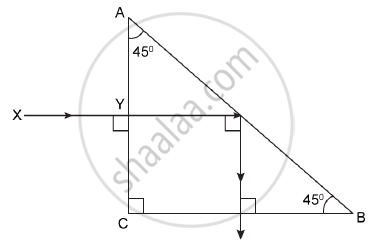
- What is the angle through which the incident ray deviates and emerges out of the prism?
- Name the instrument where this action of the prism is put into use.
- Which prism surface will behave as a mirror?
Draw a diagram of a right angled isosceles prism which is used to make an inverted image erect.
In the following figure, a ray of light PQ is incident normally on the hypotenuse of an isosceles right angle prism ABC.
- Complete the path of the ray PQ till it emerges from the prism. Mark in the diagram the angle wherever necessary.
- What is the angle of deviation of the ray PQ?
- Name a device in which this action is used.
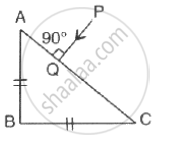
In the given figure, a ray of light PQ is incident normally on the face AB of an equilateral glass prism. Complete the ray diagram showing its emergence into air after passing through the prism. Take critical angle for glass = 42°.
- Write the angles of incidence at the faces AB and AC of the prism.
- Name the phenomenon which the ray of light suffers at the face AB, AC and BC of the prism.
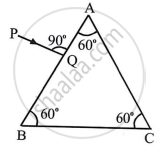
Copy the diagram given below and complete the path of the light ray till it emerges out of the prism. The critical angle of glass is 42°. In your diagram mark the angles wherever necessary.
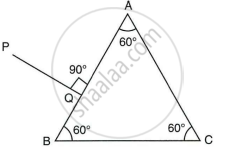
Draw a neat labelled ray diagram to show the total internal reflection of a ray of light normally incident on one face of a 30°, 90°, 60° prism.
What device other than a plane mirror can be used to turn a ray of light through 180°? Draw a diagram in support of your answer. Name an instrument in which this device is used.
Mention one difference between reflection of light from a plane mirror and total internal reflection of light from a prism.
State one advantage of using a total reflecting prism as a reflector in place of plane mirror.
Two isosceles right-angle glass prisms P and Q are placed near each other as shown in Fig. Complete the path of the light ray entering the prism P till it emerges out of the prism Q.
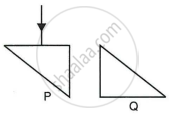
Complete the path of ray PQ through the glass prism ABC shown in Fig. till it emerges out of the prism. Given the critical angle of the glass is 42°.
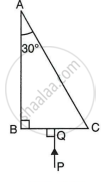
The diagram below shows a light source P embedded in a rectangular glass block ABCD of critical angle 42°. Complete the path of the ray PQ till it emerges out of the block. [Write necessary angles].
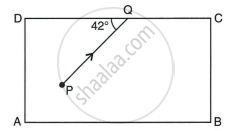
MULTIPLE CHOICE TYPE
The critical angle for glass-air interface is ______.
24°
48°
42°
45°
A total reflecting right angled isosceles prism can be used to deviate a ray of light through ______.
30°
60°
75°
90°
A total reflecting equilateral prism can be used to deviate a ray of light through ______.
30°
60°
75°
90°
Solutions for 4: Refraction of Light at Plane Surfaces
![Selina solutions for Physics [English] Class 10 ICSE chapter 4 - Refraction of Light at Plane Surfaces Selina solutions for Physics [English] Class 10 ICSE chapter 4 - Refraction of Light at Plane Surfaces - Shaalaa.com](/images/physics-english-class-10-icse_6:4c973dd038c545c9a2b6db170ad2f542.jpg)
Selina solutions for Physics [English] Class 10 ICSE chapter 4 - Refraction of Light at Plane Surfaces
Shaalaa.com has the CISCE Mathematics Physics [English] Class 10 ICSE CISCE solutions in a manner that help students grasp basic concepts better and faster. The detailed, step-by-step solutions will help you understand the concepts better and clarify any confusion. Selina solutions for Mathematics Physics [English] Class 10 ICSE CISCE 4 (Refraction of Light at Plane Surfaces) include all questions with answers and detailed explanations. This will clear students' doubts about questions and improve their application skills while preparing for board exams.
Further, we at Shaalaa.com provide such solutions so students can prepare for written exams. Selina textbook solutions can be a core help for self-study and provide excellent self-help guidance for students.
Concepts covered in Physics [English] Class 10 ICSE chapter 4 Refraction of Light at Plane Surfaces are Introduction to Refraction of Light, Speed of Light, Relationship Between Refractive Index and Speed of Light (µ = C/V), Refraction of Light Through a Rectangular Glass Slab, Prism, Principle of Reversibility of the Path of Light, Experimental Verification of Law of Refraction and Determination of Refractive Index of Glass, Critical Angle, Relationship Between the Critical Angle and the Refractive Index (µ = 1/ Sin C), Total Internal Reflection in a Prism, Some Consequences of Refraction of Light, Use of a Total Internal Reflecting Prism in Place of a Plane Mirror, Consequences of Total Internal Refraction, Multiple Images in a Thick Plane Glass Plate Or Thick Mirror, Refraction of Light Through a Prism, Real and Apparent Depth, Apparent Bending of a Stick Under Water, Transmission of Light from a Denser Medium (Glass Or Water) to a Rarer Medium (Air) at Different Angles of Incidence, Total Internal Reflection, Introduction to Refraction of Light, Speed of Light, Relationship Between Refractive Index and Speed of Light (µ = C/V), Refraction of Light Through a Rectangular Glass Slab, Prism, Principle of Reversibility of the Path of Light, Experimental Verification of Law of Refraction and Determination of Refractive Index of Glass, Critical Angle, Relationship Between the Critical Angle and the Refractive Index (µ = 1/ Sin C), Total Internal Reflection in a Prism, Some Consequences of Refraction of Light, Use of a Total Internal Reflecting Prism in Place of a Plane Mirror, Consequences of Total Internal Refraction, Multiple Images in a Thick Plane Glass Plate Or Thick Mirror, Refraction of Light Through a Prism, Real and Apparent Depth, Apparent Bending of a Stick Under Water, Transmission of Light from a Denser Medium (Glass Or Water) to a Rarer Medium (Air) at Different Angles of Incidence, Total Internal Reflection.
Using Selina Physics [English] Class 10 ICSE solutions Refraction of Light at Plane Surfaces exercise by students is an easy way to prepare for the exams, as they involve solutions arranged chapter-wise and also page-wise. The questions involved in Selina Solutions are essential questions that can be asked in the final exam. Maximum CISCE Physics [English] Class 10 ICSE students prefer Selina Textbook Solutions to score more in exams.
Get the free view of Chapter 4, Refraction of Light at Plane Surfaces Physics [English] Class 10 ICSE additional questions for Mathematics Physics [English] Class 10 ICSE CISCE, and you can use Shaalaa.com to keep it handy for your exam preparation.
